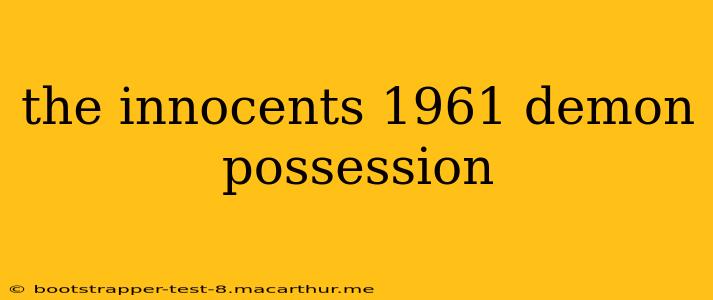Jack Clayton's 1961 film, The Innocents, remains a chilling masterpiece of gothic horror, leaving audiences to question the nature of reality and the fragility of the human psyche. Based on Henry James' novella The Turn of the Screw, the film masterfully blends psychological suspense with the unsettling suggestion of demonic possession, leaving a lasting impact on viewers. While the film doesn't explicitly depict a demonic possession in the same vein as modern horror, its ambiguity and masterful use of suggestion make it a cornerstone of the genre's exploration of the unseen and the unsettling.
What Kind of Possession is Depicted in The Innocents?
This is arguably the central question surrounding the film. Unlike more straightforward depictions of possession, The Innocents utilizes ambiguity. The spectral figures seen by Miss Giddens (Deborah Kerr), the governess, could be the result of her own repressed desires, a manifestation of mental illness, or genuine demonic entities influencing the children. The film deliberately avoids a clear-cut answer, allowing the audience to draw their own conclusions and fueling ongoing debate about the true nature of the events unfolding on the isolated estate. The possession, if one even exists, is psychological and insidious, slowly corrupting the innocence of the children rather than involving overt physical manifestations.
Is The Innocents a Ghost Story or a Possession Story?
The line between ghost story and possession story blurs significantly in The Innocents. While spectral figures are certainly present, the effects they have on Flora and Miles suggest something more akin to possession than simple haunting. The children's increasingly erratic behavior, their whispered conversations, and their disturbing connection to the unseen figures point towards a malevolent influence manipulating their minds and actions. Ultimately, the film's genius lies in its refusal to definitively label itself; it exists in the unsettling space between ghost story and possession narrative, leaving the audience to grapple with the ambiguous nature of the horror.
What Makes The Innocents Different from Other Possession Movies?
The Innocents differentiates itself from other possession films through its subtle approach and focus on psychological horror. It avoids explicit displays of demonic activity, opting instead for suggestive imagery, unsettling sound design, and Deborah Kerr's masterful performance to convey a sense of dread and creeping unease. The film's ambiguity is its greatest strength, inviting multiple interpretations and ensuring its enduring relevance. Unlike many possession films that rely on jump scares and graphic depictions of demonic influence, The Innocents creates a far more lingering and unsettling experience through psychological manipulation and the gradual erosion of innocence.
Is the Possession in The Innocents Real or Imagined?
This is the central question that remains unanswered and arguably, unanswerable. The film masterfully leaves this open to interpretation, a testament to its lasting power and enduring mystery. The ambiguity allows viewers to consider various explanations, from Miss Giddens' mental state to the genuine presence of supernatural forces. This ambiguity is precisely what elevates the film above other possession narratives, leaving a lasting impact and prompting endless discussion and analysis. The "possession" could be a manifestation of her own internal struggles, a byproduct of a repressed sexuality, or a genuine demonic presence corrupting the children. The film's power lies in forcing the audience to confront the possibility of both.
What are the Symbols of Possession in The Innocents?
The film employs several subtle yet potent symbols to suggest the presence of a corrupting influence. The recurring imagery of shadows, the children's unsettling behavior, the seemingly innocent games that take on sinister undertones, and the ambiguous appearances of the spectral figures all contribute to the overall atmosphere of unease and implied possession. These symbols function on a subconscious level, amplifying the film's unsettling power and leaving a lasting impression long after the credits roll. The ambiguity of these symbols is integral to the film’s effectiveness.
In conclusion, The Innocents stands as a testament to the power of suggestion and psychological horror. While it might not feature the explicit demonic possession scenes seen in many modern horror films, its ambiguous portrayal and masterful use of atmosphere leave an indelible mark on viewers, prompting contemplation and debate long after the final scene fades to black. Its lasting impact is a testament to its enduring power and its subtle yet chilling exploration of the fragility of innocence and the unseen forces that may threaten it.
